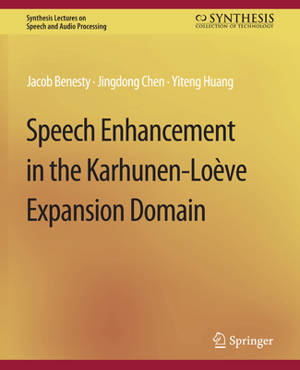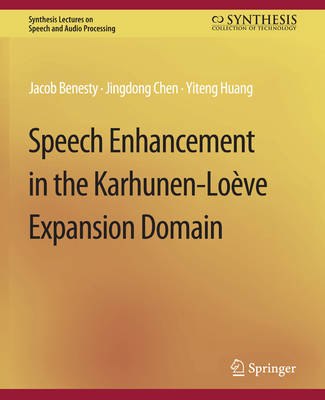
- Retrait gratuit dans votre magasin Club
- 7.000.000 titres dans notre catalogue
- Payer en toute sécurité
- Toujours un magasin près de chez vous
- Retrait gratuit dans votre magasin Club
- 7.000.0000 titres dans notre catalogue
- Payer en toute sécurité
- Toujours un magasin près de chez vous
Speech Enhancement in the Karhunen-Loeve Expansion Domain
Jacob Benesty, Jingdong Chen, Yiteng Huang
34,95 €
+ 69 points
Description
This book is devoted to the study of the problem of speech enhancement whose objective is the recovery of a signal of interest (i.e., speech) from noisy observations. Typically, the recovery process is accomplished by passing the noisy observations through a linear filter (or a linear transformation). Since both the desired speech and undesired noise are filtered at the same time, the most critical issue of speech enhancement resides in how to design a proper optimal filter that can fully take advantage of the difference between the speech and noise statistics to mitigate the noise effect as much as possible while maintaining the speech perception identical to its original form. The optimal filters can be designed either in the time domain or in a transform space. As the title indicates, this book will focus on developing and analyzing optimal filters in the Karhunen-Loève expansion (KLE) domain. We begin by describing the basic problem of speech enhancement and the fundamental principles to solve it in the time domain. We then explain how the problem can be equivalently formulated in the KLE domain. Next, we divide the general problem in the KLE domain into four groups, depending on whether interframe and interband information is accounted for, leading to four linear models for speech enhancement in the KLE domain. For each model, we introduce signal processing measures to quantify the performance of speech enhancement, discuss the formation of different cost functions, and address the optimization of these cost functions for the derivation of different optimal filters. Both theoretical analysis and experiments will be provided to study the performance of these filters and the links between the KLE-domain and time-domain optimal filters will be examined. Table of Contents: Introduction / Problem Formulation / Optimal Filters in the Time Domain / Linear Models for Signal Enhancement in the KLE Domain / Optimal Filters in the KLE Domain with Model 1 / Optimal Filtersin the KLE Domain with Model 2 / Optimal Filters in the KLE Domain with Model 3 / Optimal Filters in the KLE Domain with Model 4 / Experimental Study
Spécifications
Parties prenantes
- Auteur(s) :
- Editeur:
Contenu
- Nombre de pages :
- 102
- Langue:
- Anglais
- Collection :
Caractéristiques
- EAN:
- 9783031014321
- Date de parution :
- 04-01-11
- Format:
- Livre broché
- Format numérique:
- Trade paperback (VS)
- Dimensions :
- 191 mm x 235 mm
- Poids :
- 235 g

Les avis
Nous publions uniquement les avis qui respectent les conditions requises. Consultez nos conditions pour les avis.






